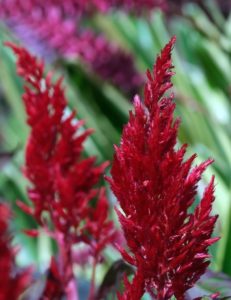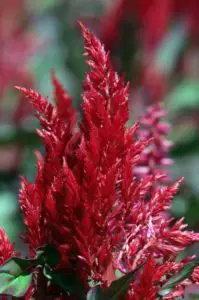Some links in the post are affiliate links and I get a commission from purchases made through some links found in the post.
Every so often we find a plant that mystifies us, either in the way it grows or in the way it adapts to certain conditions.
Celosia Dragon’s Breath confuses us because it is often debated as to whether it is an annual or a perennial. The short answer to your question.
Celosia Dragon’s Breath are annuals. Annuals are described as a plant that does not live from one year to the next but you can take steps to make your celosia dragon’s breath to last longer. You can protect it from frost or create a new plant from cuttings or seeds.
Although you may not have known the name of this plant, it is very likely that you have seen it is formal garden beds and even in flower arrangements.
Indeed, it is one of the most popular and well-used additions to landscapes where few flowers bloom and the conditions are not the best.
The flowers of the Celosia Dragon’s Breath are long-lasting and bright red with a green/red foliage. Propagation of the Dragon’s Breath is easy and quick, with minimal use made of fertilizers.
You can grow Dragon’s Breath in pots or direct in the ground – it will do well in either area. In fact, if the conditions are adverse, the plant does even better.
Heat, humidity, and infrequent watering make no difference to this plant, and it is easy to see why it is so popular.
A Little about the Celosia Dragon’s Breath
 This plant comes from tropical regions of the Americas, Asia, and Africa. It thrives in humid, hot conditions and produces large flowers.
This plant comes from tropical regions of the Americas, Asia, and Africa. It thrives in humid, hot conditions and produces large flowers.
The foliage is a red/green and often used in arrangements. The plant self-seeds and it is also easy to propagate.
Celosia Dragon’s Breath is classed as a dense herbaceous annual and grows with a spreading nature.
Is Celosia Dragon’s Breath an Annual or Perennial?
The difference between an annual and a perennial is that annuals do not live from one year to the next and perennials do live for several years.
Generally, perennials bloom for a shorter period while annuals will last well into the end of the season. For this reason, many gardeners choose a selection of both to keep their gardens in full colour for as long as possible.
The Celosia Dragon’s Breath does not live more than one year before dying off, thus placing it in the category of an annual not a perennial. You can, however, take steps to help prolong the plant life a little longer.
The plant will live a little bit longer if you bring it indoors as the days get cooler.
How long do Dragons Breath plants last?
Because dragon’s breath is an annual plant not a perennial, it will not last much longer than a season. You will find that the first frost normally kills it off.
On the bright side, this will give you around ten weeks of blooming time for your plant. If you prune dead heads off you may even prolong the life of the plant for another month.
One advantage of this amazing plant is that you can chop the dead heads back and dry them for arrangements.
If you’re enjoying this article, check out our article on how to save a dying dracaena marginata plant.
How Fast does Dragon’s Breath Grow?
It will take your Celosia about 6-13 days to germinate. With the right conditions you should see flowers forming around the 14 to 21-day mark.
Celosia Dragon’s Breath will reach maturity at about four months. For the plant to start flowering it will need less than 11 hours of daylight for three to four weeks. This will ensure that the early bud formations are not aborted.
There are some things to remember when growing your Celosia Dragon’s Breath.
Fertilizer
If you want a deeper, darker red colour then the easiest way to get this is by feeding your plants.
Aim for a calcium/nitrate-based fertilizer because excessive ammonia will feed the foliage instead of the flowers.
Fertilizer should also have adequate boron, potassium, and magnesium levels to stop odd shaped and discoloured foliage.
Temperatures
It is the cooler temperatures at night which contribute to well-toned plants with strong growth. These lower temperatures also help with the deep red flowers.
If the daily temperatures are between 68-70 degrees F the plants will be bright red.
However, if the temperatures are between 55-6- degrees F you will find even deeper red colours.
Can you Start Dragon’s Breath from Seed?
 Yes, you can start dragon’s breath from seed. You can start them in the ground or in containers and then transplant into borders. They will grow to about 20-24” in height.
Yes, you can start dragon’s breath from seed. You can start them in the ground or in containers and then transplant into borders. They will grow to about 20-24” in height.
Keep your young plants well-watered particularly if the days are dry and ensure that they get around 6 hours of direct sunlight each day.
Cut the blooms. This is the best way to have more growth. Not only will the plants survive for longer, but they will also bloom bigger through the season.
Can you Grow Dragon’s Breath Indoors?
Yes, you can grow dragon’s breath indoors. Ideally the inside temperatures should be about 20 – 25 degrees C (68-77 degrees F).
The seeds will need a warm environment to germinate. If you have a propagator then this is a great way to start them off.
You should have your first seeds sprouting in about 1-2 weeks and in the early summer you should be able to transplant them outside or repot them for indoors.
Why is my Celosia Dying?
One of the things that bothers this plant is stem rot. Cool and wet weather which is followed by humidity and hot days may be the trigger for this. You will notice this first on the lower foliage areas and stems.
Unfortunately, there is very little that will help at this point. You may want to take as many cuttings as you can before the plant dies.
How do you Revive a Dragon’s Breath Plant?
As with many plants you may notice that your Celosia flags a little after you transplant it into your pot or garden. Give the plants a good water and within 24 hours you should see that they are improving.
The way to keep your Celosia looking good is to simply give it enough water, particularly in hot, dry periods.
Does the Dragon’s Breath Plant Come back Every Year?
Because it is an annual, Celosia Dragon’s Breath will not come back the following year by itself. However, if you take a cutting from the original plant you can cultivate it yourself and have several new plants the following season.
You can have new plants ready to transplant within 3-4 weeks by taking cuttings. Simply cut off the top 4-6 “of the plant. Remove all the leaves from the bottom half.
Now place the cutting in enough water to cover the area where you have removed the leaves.
Sit back and wait, changing the water every few days. Once you have a good set of roots, you can transplant your new plant into the garden or pot.
Seeding is also easy with these plants, and you should have seedlings showing within two weeks once you have sowed them.
Is Celosia Toxic for Animals?
 No, one good things about Celosia Dragon’s Breath is that it is not poisonous for animals.
No, one good things about Celosia Dragon’s Breath is that it is not poisonous for animals.
That being said, it is best that your dog does not get into a habit of chewing your plants, even if they do not harm them. Sooner or later, they will chew on something that is dangerous or even fatal to them.
Final Thoughts
These are some of the most striking plants that you can grow in your garden.
They are so easy to grow, propagate and maintain, there is no reason why you should not find a place for them among your other plants.
Before you go, here are some more related articles I encourage you to read below to help solve more of your gardening issues:
What flowers only bloom once a year?


